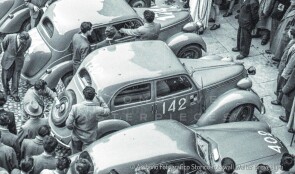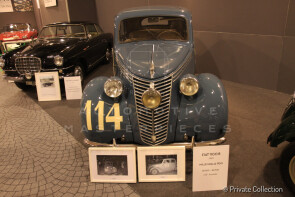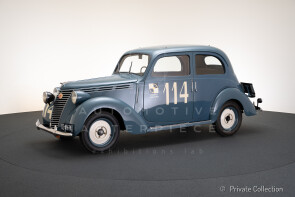
1949 Fiat 1100 B
ON/OFF
Why am I an Automotive Masterpiece?
G. Team cars
Squadra Garisenda
There are many cars loved for one reason or another. Some recall specific aspects of our history. Few, like the Fiat 1100, tell so many stories of Italy, from the late 30s to the late 60s. The 1100 was born from an offshoot of the Fiat 508C, the Nuova Balilla 1100 and was nicknamed "musone" due to the imposing grille. The Fiat 508 C was first introduced in 1937, powered by a 1,089cc 4-cylinder engine, instead of the previous 1-liter Balilla. Power increased by a third, to 32 hp at 4,000 rpm. At the time, its comfort, handling and performance were prodigious, making it "the only car for the people that was also the car for a driver". Unusual for a low-priced car of the time was the independent front suspension. In 1939 the car underwent a makeover of the nose and became the Fiat 1100, sometimes known “retrospectively” as the 1100 A to distinguish it from the following models. The car had received a taller and more defined grille, which earned it the popular nickname of 1100 "musone": with horizontal chrome bars, the top three extending backwards on window-shaped openings on each side of the engine hood, redesigned. There were six body types available, all derived from the previous model: sedan, convertible sedan, convertible, sports sedan, long wheelbase and taxi. No significant changes were made to the mechanics of the car. After World War II, in 1948, the 1100 received some mechanical and interior updates and was renamed 1100 B. The revised 1100 B engine produced 35 hp at 4,400 rpm, thanks to larger intake and exhaust manifolds and to a larger carburetor. Inside, a new steering wheel and new instrumentation. The 1100 B was available as a sedan, long wheelbase and taxi. A total of 25,000 units were built between 1948 and 1949. The 1100 B only lasted a year, until 1949, when the car was reintroduced with a new trunk and a new name, 1100 E.
23 and 24 April 1950: at the Mille Miglia, no less than 204 of the registered starters were production cars. In that year, history meets legend: after thirteen hours of driving that led him to victory, with about seven minutes ahead of the crew that followed, Count Giannino Marzotto got out of his car wearing a double-breasted suit and a tie matching the color of his car, a Ferrari 195 S Berlinetta Touring in an unusual pastel blue livery. But other stories alternate that year during the race; one is the one that brings, with race number 114, the Fiat 1100 B with chassis no. 311918 to cover the 1500 km route without fail, with the crew Paolo Rossi - Alessandro Rossi, to rank 125th overall and 35th in the Turismo 1100 category, maintaining a respectable average speed of 86.24 kph on the course. The car has therefore obtained the certification of the 1000 Miglia Register and the proof of the time is evidenced by numerous photos that portray it both in Brescia and in the passage through Florence. The car also raced the Volante d’Argento, in September of the same year, ranking an honorable 3rd position in class. The car then seems to have had a quieter life in later years, mostly in Italy. The car was restored in its wonderful ash blue and wears the same livery with which it raced in 1950, with the same race numbers, the insignia of the “Squadra Garisenda” team, the third central headlight.





